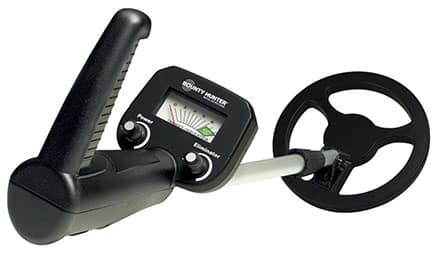This article contains affiliate links. If you make a purchase after clicking on a link I may earn a small commission at no extra cost to you.
 People may have a different understanding of what a metal detector is. Most people know it for being used for treasure hunting for finds like gold, coins and other small valuables. Others liken it to devices used in airport security or in the form of handheld scanners used by security guards at concert events.
People may have a different understanding of what a metal detector is. Most people know it for being used for treasure hunting for finds like gold, coins and other small valuables. Others liken it to devices used in airport security or in the form of handheld scanners used by security guards at concert events.
Here are our favorite 7 metal detectors for beginners
Regardless, the technology has grown to be a big part of our lives. Offices, schools and prisons all use it for the purpose of detecting harmful items that can be used as weapons.
Recently, the growing trend of metal detecting for sport has evolved today where people are buying full-sized portable metal detectors for purposes like beach metal detecting to uncover historical finds from 100s of years ago.
The Basic Components Of A Metal Detector
A metal detector should employ a lightweight design and include 4 main parts:
A stabilizer is attached to the top of the unit for the user’s hand to hold or arm to rest in while they detect.
Next, the control box sits below and made up of all the circuitry, batteries, speakers and microprocessor of the metal detector.
The search coil is the part which picks up all the metals detected and relays it back to the control box. It works like a TV antenna. Not sure what the different types of coils are? We have created an in-depth article about the 5 different metal detecting coils, what they are used for, what to look for and sizes,
Finally, the shaft connects the search coil to the control box and should be adjustable to suit the user’s height.
Most metal detectors will support headphone use by having a jack to plug headphones into them. Other variations sit the control box under the shaft with a small display placed over it.
Operating a metal detector is fairly straight forward. Once the detector is turned on, the person will slowly move over an area. While moving, they will sweep the search coil in a back-and-forth motion over the ground around them. As the coil passes over a targeted object, it will emit an audible signal to the user. Advanced units allow for more information about immediate finds such as the type of metal detected and the depth it’s located.
Three different technologies are used in a metal detector:
VLF Metal Detecting
Very Low Frequency technology (VLF) is the most popular one that’s used today. This metal detector employs 2 distinct coils. A Transmitter Coil is the outer coil which inside contains wires that pass electricity up and down it 1000 times per second. The unit’s frequency (measured in MHz) depends on how many times the direction of electrical current switches every second.
The Receiver Coil is the inner coil that’s made up of another wire coil. Again, the wire works like an antenna to detect the frequencies of targets underground and amplify their signals. VLF metal detectors rely on ‘Phase Shifting’ to tell different metal types apart. Phase Shifting is a difference in time measured from the frequency of the transmitter coil to the target objects in the ground.
PI Technology
Called by some to be the best metal detector technology, PI (Pulse Induction) differs from VLF because it uses 1 coil as both a transmitter and receiver. Some however, are known to use multiple coils at once. Powerful pulses travel along the wire coil that creates small magnetic fields. When these run out, the polarity gets reversed by the magnetic fields then suddenly collapses to make an electrical spike. In microseconds, the spike runs out after it generates another current to move through the search coil.
PI detectors are able to pick up metals buried far deeper than other metal detecting technologies.
A BFO Metal Detector
The most basic form of metal detecting technology is BFO (Beat-Frequency Oscillator), which uses 2 wires coils. The larger coil is put in the search head while the smaller one is placed inside the detector’s control box. An oscillator is connected to each coil and generates 1000s of current pulses per second. The pulses of these frequencies are slightly offset in-between both coils.
As they travel, radio waves are generated.
The tiny receiver sitting inside the control box of the metal detector reads the radio waves then creates a sequence of audible tones depending on the frequency difference. When the coil travels over an object, a magnetic field gets created around it by the one resulting from the flowing current.
Finally, the audible tones change once the coil’s frequency in the metal detector’s control box deviates.
A BFO metal detector system can be sold at a low price because of its simple design; however, they don’t offer the same degree of accuracy and control put forward by the other 2 technologies.
Make Sure You Do Your Research on Your Metal Detector And To Understand How Does A Metal Detector Work.
By doing your research and becoming familiar with the different types of metal detectors available on the
Click Here To Read Which Are The Most Popular Metal Detectors






